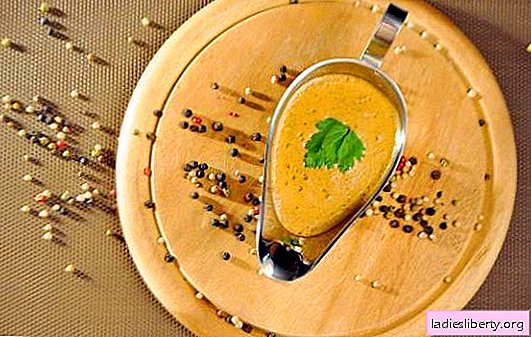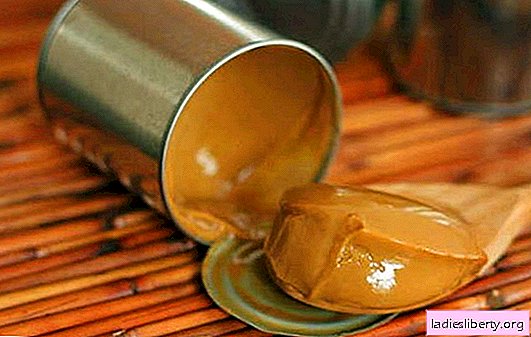
The collection of recipes for sauces is replenished daily as much as the inexhaustible variety of ingredients that exist throughout the world. The fantasy of famous and yet unknown chefs is also a powerful engine for expanding the encyclopedia of sauces. It is absolutely possible that the best sauce can be invented and made not by the chef of the most famous French restaurant, but by a simple housewife, in a distant, little-known provincial town.
If you want to serve a dish with something more interesting than mayonnaise or ketchup, then it's time to pay attention to one of the most voluminous sections of cooking devoted to sauces.
Pepper sauce - recipes, basic principles of preparation
In order for the famous masters of cooking to recognize the recipe as brilliant, you need to add to the imagination the knowledge of the basics of making sauces.
Each person recognizes sweet, salty, sour and bitter instantly as soon as food enters the mouth. Next is ordinary biochemistry. If these four shades of taste are moderately balanced among themselves, the brain remembers the taste and appearance of the dish as causing pleasure, and vice versa. Thanks to Academician Pavlov, but back to cooking.
It is the sauce that finally forms the taste of the dish, sets, so to speak, the final accents. A beautifully fried steak in itself has a completely neutral taste, and without sauce it is unlikely to cause an appetite.
So, should four tastes be in perfect harmony with each other? Not always. If the sauce is served in a neutral taste dish, then balance in the sauce is necessary. If the dish, for example, is a sweet dessert, then it will be decorated with a sauce of sour berries or fruits, but bitterness will be inappropriate. Many professionals rightly believe that salt should be added to sweet dough, because it enhances sweetness due to contrast.
All spices and herbs known today were originally a substitute for medicine, and then began to be used in cooking. Spicy spices are used in cooking to stimulate appetite, stimulate blood flow, metabolic processes. The sharpness of sauces also contributes to calorie burning. Hot pepper sauces are an excellent antimicrobial agent, a natural antiseptic.
The main component of pepper sauces is chili, cayenne pepper, mustard, all hot spices. In addition to a spicy sauce, any spicy herbs can be combined to taste with the main course. In the composition of pepper sauces acid, sweetness in moderation, and salt are quite appropriate. Particular piquancy is achieved with tart and astringent, nutty shades, the presence of alcohol, fruit flavors.
But it’s enough to fry the same steak and sprinkle with dry pepper, and why then prepare the sauce? The liquid base adds juiciness to the dish, improving the digestion of food, and this can not be achieved by using spice-flavor mixes in a dry form. In addition, the combination of several flavors in a liquid or oil base enhances their extraction, getting into the digestive system in a prepared form, and immediately involved in metabolic processes.
The base for the sauce can be broth, water, juice, milk or cream, alcoholic drinks or vinegars, egg-oil mixtures. As a thickener for the preparation of sauces, flour or starch with the addition of oil is used: the flour is fried until creamy, combined with fat, and then white or red broth from meat, poultry, fish, vegetables or mushrooms, fruits is added. The classic basis for sauces is the famous bechamel (with the addition of milk), espaniol (on red broth from fried meat), velut (on fish or chicken broth). The main Dutch sauce is steamed, from an egg-oil mixture. Sauces are also prepared in a cold way, based on vegetable oils, eggs, with the addition of wine, juice or vinegar, as a basis. Cold sauces include emulsion mixtures such as mayonnaise.
Further preparation of the sauce involves imparting the necessary consistency (density). After the base give a characteristic taste and aroma with the help of spices.
Try to cook the most famous pepper sauces in world cuisine. A few recipes are attached below, but without specifying the amount of ingredients, because spices are a matter of taste. Given that spicy food is contraindicated in people with chronic diseases of the digestive system, each housewife can independently determine the acceptable norm of severity.
1. Pepper sauce - Harissa recipe. South African cuisine
This paste-like sauce based on vegetable oil has already become popular in Israeli and European cuisine, but in the cuisine of African countries it is the most spicy and is used everywhere, being a universal seasoning for meat, fish, pasta, rice, vegetables. The sauce has several varieties. The most refined and expensive Harissa in its composition contains rose petals.
Ingredients:
Chile, red (fresh or dry)
Garlic
Zira
Coriander
Mint
Olive oil
Vinegar (or lemon juice)
Salt
Cooking method:
In the original recipe, only red chili pepper is used fresh or dried, with the addition of the listed spices. All components are ground with coarse salt in a mortar. Then oil and vinegar are added to them. Consistency is identical to thick sour cream. The sauce has a rich bright red color, thanks to the chili. If you are afraid of extreme severity, then remove the seeds of peppers that contain the highest amount of capsaicin. Reduce the sharpness without losing the original appearance and consistency will help a less sharp red pepper, and instead of vinegar or lemon juice, use a thick tomato paste.
For lack of mortar, you can use a blender.
2. Pepper sauce - a recipe for Shatt. Egyptian cuisine
Ingredients:
Chile
Parsley (leaves)
Tomatoes (pasta)
Olive oil
Salt
Cooking:
The consistency of the sauce is pasty. Therefore, it is more convenient to use ready-made tomato paste. Dry the washed pepper, remove the stalks, seeds. Wash the parsley leaves. Cut the pepper and parsley, put in a metal bowl, chop the submersible blender. The choice of this method of grinding is not accidental: it will be easier to wash metal dishes after such a burning mixture. Combine the cooked pasta with tomato, add salt, olive oil and arrange in banks.
This sauce can be prepared for the future, use it for cooking other, less spicy sauces, gravy for main dishes, marinades. For storage, pasteurize the sauce in jars, or put in a sterile container, previously bringing to a boil.
3. Pepper sauce - Guacamole recipe. Mexican food
This is one of the variations of avocado sauce. The consistency of sauces can be different: from mashed potatoes to small pieces. The composition, in addition to the listed components, often includes tomatoes, garlic. Guacamole is served with a wide variety of dishes.
Ingredients:
Avocado
Hot pepper, green
Lemon juice
Cilantro fresh
Onion
Salt
Butter
Cooking:
The severity of the sauce is medium. To obtain a puree mass in green tones, use peppers ripped in the stage of technical ripeness. Remove stalks and pepper seeds.
Sprinkle the pulp of avocado immediately with lemon juice to avoid oxidation of the fruit. Grind all components of the sauce with a blender. Salt, add oil and mix thoroughly.
The sauce can be combined with mayonnaise and added to salads. Store in the refrigerator, in a tightly closed jar, but not more than 5-7 days.
4. Pepper sauce - Salsa recipes. Mexican food
There are also a lot of varieties of this sauce. Consider two classic versions of Salsa, green and red sauce, which can be easily prepared at home. Salsa has a different consistency. The liquid sauce is prepared on the basis of vegetable broth, but if you want to prepare the sauce for the future, for the winter, then exclude the broth from the composition, and boil the tomatoes to a paste to obtain a concentrate. The consistency of the sauce is thick, heterogeneous.
First way:
Tomatoes
Red chili
Coriander
Bow
Garlic
Ground black pepper
Coriander
Salt
Olive oil
Cilantro
Cooking:
Heat oil in a pan, add ground spices and garlic. Warm up for half a minute and add finely chopped tomatoes, seedless and seedless. Simmer over low heat to evaporate tomato juice. Chili can be used both fresh and dried. Add finely chopped onions, and sauté until transparent. Put chopped cilantro leaves in the sauce two minutes before cooking. Cover the sauce, let stand until completely cooled. Adjust the amount of ingredients as you wish.
Serve with baked meat and vegetables. In hot form, salsa with tomato can be served with side dishes of cereals, pasta, potatoes.
The second way:
Green chili
Leek
Olives (pickled)
Wine, dry (or vinegar)
Olive oil
Cooking:
The sauce is based on olives, so at least half of them should be contained in the total mass. Chili pepper for this recipe should be selected in the stage of technical ripeness, when it has a green color. Add dry wine, vinegar or lemon juice to taste. If necessary, salt can be added. Optionally, add spicy greens, ginger root. Grind all components in a blender bowl at the same time until a homogeneous consistency. Before use, soak the sauce in a closed container for 10-12 hours, so that all the flavors are combined in it
5. Pepper sauce - chicken curry recipe. Indian kitchen
Curry can certainly be called the “calling card” of all the regional cuisines of India. This is a dry mix or sauce. The finished mixture is easy to purchase at every major outlet, and on its basis to prepare the sauce. Just keep in mind that a dry mix can contain from ten to twenty ingredients, depending on what dishes it is intended for. Curry is not necessarily spicy, but always spicy, although each mixture contains chili and other types of peppers. Indian housewives now also use ready-made mixes, although an older generation prefers to cook them on their own. Each hostess adds all the components for curry to their taste, in an arbitrary amount.
Ingredients:
For dry mix - chili, black, Jamaican (allspice), sweet paprika;
cardamom, turmeric, zira (cumin), cloves, mustard, cardamom, ginger, nutmeg, fenugreek;
Salt
Sesame oil
Coconut milk
Mashed Tomato
Onion
Flour (or Starch)
Bouillon
Cooking:
In a dry frying pan, fry the flour until creamy, and transfer it temporarily to a separate plate. Heat oil. Put in it the prepared ground mixture of the listed spices. Sauté the chopped onion until a light golden hue. In a small amount of broth, dilute tomato puree, thickening flour, combine with coconut milk. Pour the resulting mass into a pan and, stirring, cook until thickened. Salt.
Ready sauce should have a medium and uniform consistency. Pour the sauce into a blender and beat it.
If you don’t like the smell of coconut milk, you can replace it with cream. The sauce goes well with fried poultry, vegetable side dishes and rice.
6. Pepper sauce - Wasabi recipe. Japanese food
If you want to know what a wasabi sauce really looks like, then get the powder of this root using the services of specialized stores. The famous pasta sauce is far from all sushi sellers cook from wasabi roots, which are cultivated only in East Asia. A rare plant in our area is replaced with horseradish, adding various dyes of green color. In fact, wasabi is really a kind of horseradish, but only this species grows in one single region of Japan, and its cultivation is not an easy task. The high cost of the root is fully justified by its healing properties, the complexity of its agricultural technology. But that is not all! Wasabi powder is a type of daikon with the same properties as a real wasabi root, with the exception of color. Wasabi has a characteristic green color, and daikon wasabi is white. This is a forced trick of sellers, and it is associated with a very short shelf life of green burning root. Culinary specialists tint daikon wasabi with green pepper, spinach, spicy green leaves.
Ingredients:
Wasabi Powder
Fat cream, culinary 120 ml
Mustard oil 90 ml
Ginger root
Lime juice
Green chili
Soy sauce
Spinach Leaves (for color)
Cooking:
Cool and whip the cream, adding a drop of oil. This is the basis of the pasta sauce, to which you need to add all the other ingredients. Beat the finished sauce thoroughly with a blender, and let the pasta in the refrigerator for at least an hour. You can add these ingredients to the base of mayonnaise, replacing them with cream and butter.
Real wasabi is a powerful antimicrobial agent that cleanses the body even with raw fish.
Pepper Sauce - Recipes and Useful Tips
When preparing hot pepper sauces, be sure to wear gloves to avoid skin burns. In addition to burning capsaicin, pepper contains oil, which is difficult to wash off with conventional means. Therefore, try to use metal utensils, which, unlike plastic containers, do not absorb the substances contained in pepper.
Do not drink pepper sauce with water if you feel that you have gone too far with seasoning. Dairy products (yogurt, ice cream, milk), boiled rice, lemon juice do an excellent job of unwanted burning. Water only enhances the action of capsaicin. In the process of working with hot peppers in the kitchen, make sure that you have at hand something from dairy products. If pepper accidentally enters the mucous membrane of the eyes, nose, wipe the burned areas with a swab dipped in milk, and then rinse with water.











